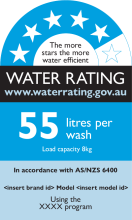
15-20% of water used in the home is in the laundry.
- Make sure your hot water system thermostat is not set too high - ideally no higher than 60°C. Adding cold water to cool very hot water is a waste.
- Leaking taps can usually be fixed with a new washer, this is easy to do. Just remember to turn the water off at the mains before you start.
- If the tap still drips, call a plumber. The cost incurred will save you money on your water bills in the long run.
- Insulate hot water pipes, this avoids wasting water while waiting for hot water to flow through and saves energy.
- Install water efficient tapware or retrofit old tapware with aerators or flow control valves
Washing machine tips
If you are in the market for a new washing machine choose a 6 star WELS rated model.
To save water and energy, always run your washing machine on full load.
Adjust the water level to suit the size of the wash load - some new water efficient models will do this automatically.
Washing in cold water saves energy and may not compromise the quality of the wash.
Use the sud-saver option - if your machine has one - when you have several loads to wash.
Choose a top-rated washing machine
Before buying a new washing machine, check the manufacturer’s water efficiency labels. Australia’s Water Efficiency Labelling and Standards (WELS) scheme allows consumers to compare the water efficiency of different products using a star rating system. By buying more water efficient products you can save money on water and electricity bills and help the environment!
Front loader or top loader?
Before buying a new washing machine, consider whether you prefer a front or top loader. Front-loading washing machines achieve 6 stars in the WELS Water Rating Label and are more water and energy efficient than top loaders.
Front loading washing machines have an opening on the front of the machine, where clothes can be loaded and unloaded. All dials and buttons are typically located on the front.
Top loading washing machines open from the top of the machine, where clothes can be loaded and unloaded. The dials and buttons are typically found on top, along the back edge of the machine.
How's it going to wash?
Front loaders are gentler on the clothes than top loaders. They have higher spin speeds resulting in less moisture in the clothes on completion. This shortens drying time and minimises the use by a tumble dryer. In terms of dirt removal or rinse performance, neither type has an advantage, but front loaders offer more temperature and wash options.
I want to save water and energy
One of the biggest advantages of front loaders is that they use less water than top loaders, up to 70% less in some cases or 36,000 litres per year for a typical household. They also use less detergents and less energy if you wash with warm or hot water. This reduces greenhouse gases making front loaders more environmentally friendly than top loaders.
How easy is it to load washing?
Front loaders on the floor require bending to load and unload, unlike top loaders which could cause problems for those with back problems. However, these problems are reduced if front loaders are placed on pedestals or a purpose-built cabinet.
Saving space
Front loaders are very effective space savers. A dryer can easily be mounted on top of the machine without interfering with its operation.
Can I add clothes after turning the machine on?
These days most front loaders can be opened once the cycle starts. Just pause the machine and the door will unlock.
How long does it take to wash?
Front loaders generally take longer to complete a cycle than top loaders, sometimes up to 40 minutes more.


